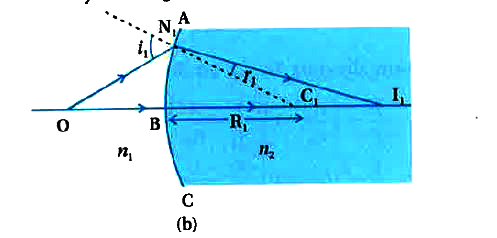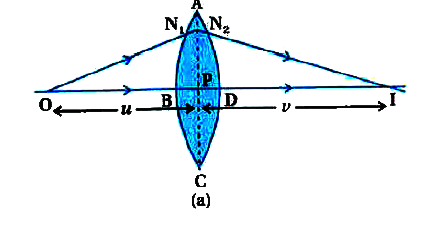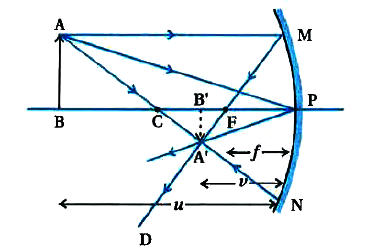Explain how the image is formed by thin convex lens and derive Solution in Gujrati
Figure shows the geometry of image formation by a double convex lens. The image formation can be seen in terms of two steps.
The first refracting surface forms the image , of the object O figure (b).

The image , acts as a virtual object for the second surface that forms the image at I figure (c).

Thus, the image formed by thin lens is shown in figure (a).

For refraction at interface ABC,
... (1)
A similar procedure applied to the interface ADC gives,
... (2) (Refractive index of medium on right side of ADC is n, while on its left it is ).
For a thin lens, , = . Adding equations (1) and (2),
Suppose the object is at infinity i.e. OB and DI = f.
Now dividing by on both sides
... (3)
equation (3) is known as the lens maker.s formula.
It is useful to design lenses of desired focal length using surfaces of suitable radii of curvature.
Note that the formula is true for a concave lens also. In that case R, is negative, R, positive and therefore f is negative.
Topper's Solved these Questions
- RAY OPTICS AND OPTICAL INSTRUMENTSBook:KUMAR PRAKASHANChapter:RAY OPTICS AND OPTICAL INSTRUMENTSExercise:SECTION - A (TRY YOURSELF)
Explore 74 Videos
- RAY OPTICS AND OPTICAL INSTRUMENTSBook:KUMAR PRAKASHANChapter:RAY OPTICS AND OPTICAL INSTRUMENTSExercise:SECTION-B (NUMERICALS)(NUMERICAL FROM TEXTUAL ILLUSTRATIONS)
Explore 17 Videos
- MOVING CHARGES AND MAGNETISMBook:KUMAR PRAKASHANChapter:MOVING CHARGES AND MAGNETISMExercise:SECTION D (MCQs ASKED IN COMPETITIVE EXAMS)
Explore 34 Videos
- SAMPLE QUESTION PAPER Book:KUMAR PRAKASHANChapter:SAMPLE QUESTION PAPER Exercise:PART-B SECTION-C
Explore 5 Videos
Similar Questions
Give range of wavelength of visible light.
View SolutionSuppose that the lower half of the concave mirror.s reflecting surface as shown in figure is covered with an opaque (non-reflective) material. What effect will this have on the image of an object placed in front of the mirror ?

View SolutionElectric charge Q having mass M moves on a circular path of radius R with velocity →v, perpendicular to uniform magnetic field B. When a particle completes one revolution, work done by the field is _______
View SolutionTwo charges –q and +q are located at points (0, 0, –a) and (0, 0, a), respectively.
(a) What is the electrostatic potential at the points (0, 0, z) and (x, y, 0) ?
(b) Obtain the dependence of potential on the distance r of a point from the origin when r/a>>1 .
(c) How much work is done in moving a small test charge from the point (5,0,0) to (–7,0,0) along the x-axis? Does the answer change if the path of the test charge between the same points is not along the x-axis?
View Solutionउत्तल लेंस के लिए सूत्र 1v−1u=1f निगमित कीजिए।
View Solutionकिसी पतले लेंस के लिए सिद्ध कीजिए कि 1f=(μ−1)(1R1−1R2) जहाँ संकेतों के सामान्य अर्थ है।
View Solutionउत्तल लेंस में वास्तविक प्रतिबिम्ब हेतु 1uऔर 1v बीच ग्राफ बनाइए।
View Solutionलेंस समीकरण 1v−1u=1f की सहायता से दर्शाइए कि
उत्तल लेंस के प्रकाशिक केन्द्र तथा फोकस के बिच रखी वस्तु का प्रतिबिम्ब आभासी तथा बड़ा होता है |
View SolutionUsing lens maker's formula, derive the thin less formula 1/f=1/v-1/u for a biconevex lens.
View SolutionLet f(x)=sinxandg(x)=(log)e|x| If the ranges of the composition functions fogandgof are R1andR2, respectively then (a) R1{u:−1≤u<1},R2={v:−∞v<0} (b) R1={u:−∞<u<0},R2={v:−∞<v<0} (c) R1={u:−1<u<1},R1={v:−∞V≤0}
View SolutionDerive Dm=A(n21−1) for thin prism.
View SolutionDerive lens formula [1v−1u=1f] for a thin convex lens, using diagram for the formation of a real image by convex Lens.
View SolutionDerive Lens formula for [frac(1)(v)-frac(1)(u)= frac(1)(f)] a thin convex Lens, using ray diagram for the formation of a real image by Convex Lens.
View Solution(1r1+1r2)(1r2+1r3)(1r3+1r1) =
View SolutionNature of the graph between 1//u and 1//v for a convex lens, where u is the distance of the object and v is that of image is
View Solution